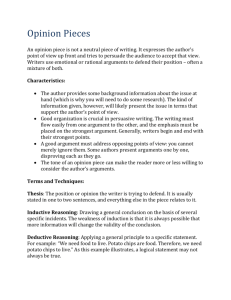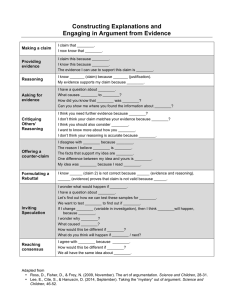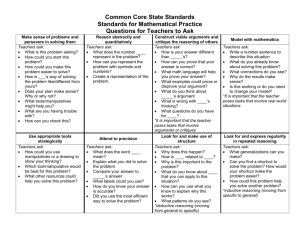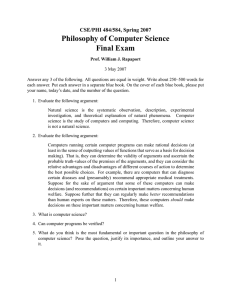AS/A level Thinking Skills 9694 Unit 4: Critical Reasoning www.XtremePapers.com
advertisement
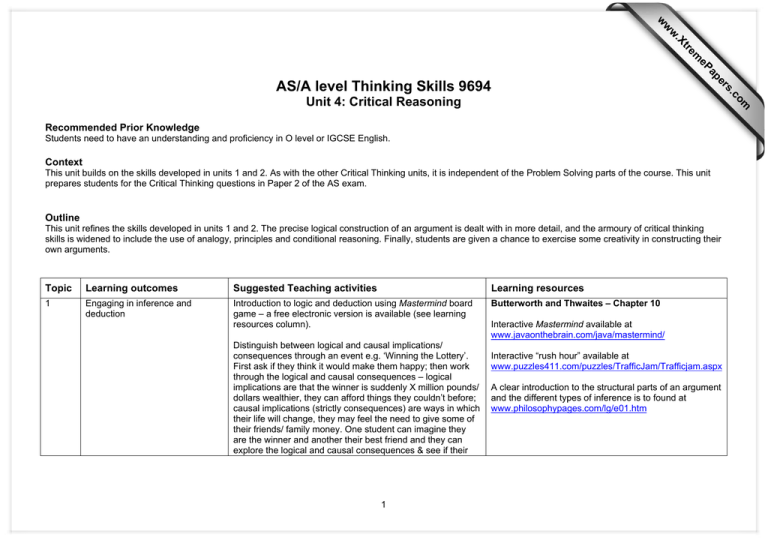
Unit 4: Critical Reasoning Recommended Prior Knowledge Students need to have an understanding and proficiency in O level or IGCSE English. Context This unit builds on the skills developed in units 1 and 2. As with the other Critical Thinking units, it is independent of the Problem Solving parts of the course. This unit prepares students for the Critical Thinking questions in Paper 2 of the AS exam. Outline This unit refines the skills developed in units 1 and 2. The precise logical construction of an argument is dealt with in more detail, and the armoury of critical thinking skills is widened to include the use of analogy, principles and conditional reasoning. Finally, students are given a chance to exercise some creativity in constructing their own arguments. Topic Learning outcomes Suggested Teaching activities Learning resources 1 Engaging in inference and deduction Introduction to logic and deduction using Mastermind board game – a free electronic version is available (see learning resources column). Butterworth and Thwaites – Chapter 10 Distinguish between logical and causal implications/ consequences through an event e.g. ‘Winning the Lottery’. First ask if they think it would make them happy; then work through the logical and causal consequences – logical implications are that the winner is suddenly X million pounds/ dollars wealthier, they can afford things they couldn’t before; causal implications (strictly consequences) are ways in which their life will change, they may feel the need to give some of their friends/ family money. One student can imagine they are the winner and another their best friend and they can explore the logical and causal consequences & see if their 1 Interactive Mastermind available at www.javaonthebrain.com/java/mastermind/ Interactive “rush hour” available at www.puzzles411.com/puzzles/TrafficJam/Trafficjam.aspx A clear introduction to the structural parts of an argument and the different types of inference is to found at www.philosophypages.com/lg/e01.htm om .c s er ap eP m e tr .X w w w AS/A level Thinking Skills 9694 Topic Learning outcomes Suggested Teaching activities Learning resources initial instinct – inevitably that it would make their lives a lot happier – still stands. (This careful working through of implications, and consideration of the certainty with which they follow, is a good way to encourage longer, more developed argumentation in extended writing (see below).) 2 Analyzing and evaluating evidence and argument The film “Twelve angry men” is a good introduction to the different approaches to criticising evidence. (Also ‘All the President’s Men’.) Butterworth and Thwaites – Chapter 15, 16, 17 & 18 Thomson – chapter 2 An archive of articles for criticism and analysis is available at www.causeweb.org/wiki/chance//index.php/Main_Page Analysing and assessing evidence: Some time is needed on establishing what the criteria are for assessing witness evidence, and also other sources of corroborative evidence e.g. photos/ film footage – e.g. things like neutrality/ vested interest/ ability to observe/ selectivity/ context (this can be done by first considering what kind of people they trust – maybe from a list including famous figures, and then looking at a fairly simple scenario like a series of statements about a crime – perhaps an imagined one in the school where certain pupils/ staff may have vested interest!). Also, sorting the evidence according to factual observation and judgement/ interpretation (students can create little mimes/ role plays and the rest of the class decide what they have actually observed and what inferred). The statements of witnesses in a detective story e.g. ‘Murders in the Rue Morgue’ Once the list of relevant criteria is established, students are given different accounts of a particular event (either listening or reading), and in pairs or small groups judge the accounts against the criteria, perhaps in the form of a table – criteria e.g. expertise can be judged as either simply present or Newspaper articles, Internet reports of an event e.g. a UFO sighting, where there are different accounts or interpretations of what happened (choose at least one where there is some reasoned argument/ inferences included, e.g. a scientist’s view of what happened). 2 Topic Learning outcomes Suggested Teaching activities Learning resources absent, or by degree (low/ high); students then write up an evaluation of the relative credibility of each account. A good source of thought-provoking alternative explanations for events in the news is http://www.theinsider.org/ The analysis of argument needs to build on the analysis of flaws and implicit assumptions studied in units 1 and 2, to include the assessment of analogies, the use of conditional reasoning (in particular, reductio ad absurdum – see Galileo’s argument in Fisher) and the use of principles (as an extension of the analysis of implicit assumptions). Also students need to be given longer arguments to summarise/ identify the main parts thereof. Students can add headings or subheadings summarising/ identifying the main points in that paragraph/ section. Butterworth and Thwaites – Chapter 19,24 and 25 Thomson – Chapter 3, 4 and 5 For an informal discussion of conditional reasoning see “Logic and its limits” by Shaw – Chapter 15 A more formal look at reductio ad absurdum is given in Polya – reductio ad absurdum and indirect proof (Pages 162-171) A good way to help spot underlying principles is to imagine a reasoning robot which has absolutely no values whatsoever and functions purely on logic – it can then be ‘tested’ by reading it arguments and seeing if it agrees with every step – beginning with simple things like ‘Capitalism can sometimes lead to great divides in wealth; therefore capitalism is an unfair economic system’ (students can raise their hands if they think it would object by spotting the principle i.e. ‘A fair economic system is one where wealth is distributed equally’; braver students could even role play it). For reasoning in a scientific context, students can be given the materials and then their understanding tested by ‘consequence cards’ (or to save preparation just a list!) where they have to decide whether or not individual consequences of the information are certain, probable, unlikely or impossible – they can also think of further ones with which to test other groups. 3 A good lesson starter on analogies is to be found at www.sadlieroxford.com/phonics/analogies/analogiesx.htm This is an interactive game involving pairing words which have the same analogical relationship. A number of interesting analogies are discussed in “Logic and its limits” by Patrick Shaw – Chapter 14. A good site to get students thinking about ways in which people often make points badly and yet also persuasively is Bad Moves by Julian Baggini – www.butterfliesandwheels.org/archived/badmoves/ (NB quite broad coverage so may be more appropriate at A Level, although quite readable – recommended for stronger, independent learners.) Topic Learning outcomes Suggested Teaching activities Learning resources 3 Constructing argument This can extend from the formation of further arguments for a given extract, to the construction of an entire argument focussing on a given conclusion. Butterworth and Thwaites – Chapter 22 A natural forum for the construction of arguments is a debating club, or the organisation of a debate within the class. www.idebate.org is a well-organised resource, with a library of stimulating topics and extensive internet references. Debate leads into individual writing where they put forward their own case (which may or may not reflect the concerns of the group they were representing). Students who are struggling to develop or extend their ideas should be encouraged to follow the implications through in the way that was practiced earlier for each of the points they make. Encourage students to act as judges in debates [arranging for older students to act as judges, helpful critics and role models for younger debaters can provide a perfect theatre for critical discussion]. 4

